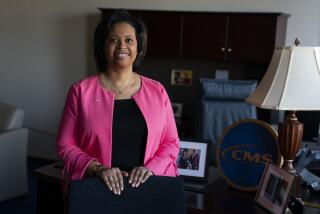Press Found Putting Stress on Politics of Health Reform : Media: New study also reveals that public seems to grow more confused over Administration plan. Insurance industry ad campaign may be a cause.
- Share via
WASHINGTON — Press coverage of health care reform has been balanced but it has tended to emphasize the politics rather than the medical fallout of reform, a new study of the public and the press reveals.
As time has gone on, the study released Friday also asserts, the public appears more confused about what is contained in the Administration’s health care proposal than it was when the proposal was first announced in September.
These are some of the results of a “monitoring project” on health care by the Kaiser Family Foundation, the Times Mirror Center for the People and the Press and the Columbia Journalism Review. The findings, the second installment of the monitoring project, are derived from a public opinion survey and a content analysis of 2,000 newspaper, magazine and television stories about health care published between Sept. 1 and Nov. 30, 1993. That roughly covers the period from the President’s introduction of the health care plan to a joint session of Congress through Thanksgiving last year.
The content analysis found press coverage “overwhelmingly balanced or neutral,” with 80% of the stories about policy disputes falling into this category, 73% of the stories about the prospects of passage in this category and 68% of the stories about President Clinton in this category.
Those stories that were not neutral tended to be critical of the Administration or its plan.
But the survey was more critical of the focus of the press coverage. The largest single category of stories, 31% of the combined print and TV reports, focused on the political impact of health care, such as on the President’s standing or those of other political figures.
The next largest focus of coverage, 21% of the stories, concerned the impact of reform on the health care system, such as the structure of health alliances or how they affected insurance companies.
Next, 17% of the coverage concerned the effect of reform on individuals and families.
The rest of the coverage concerned “the broader nonpolitical impact of reform” (12%), the economic aspects of reform (12%) and the impact on doctors and nurses and medicine (6%).
The study found some differences by media. Television coverage was more driven by events--a presidential speech, a press conference--while print coverage provided more background of the plans and the economic aspects. Television coverage, however, was found to focus more than print on the consequences of reform on individuals.
But the public opinion survey also found that public awareness of the health care plan has dropped in the months since Clinton proposed the plan in September. In December, for instance, 54% correctly answered that the Clinton plan would guarantee health care for all, down from 64% in September.
The number of people who thought they would have less freedom to choose a doctor grew, to 54% in December from 44% three months earlier.
Several factors may account for these changes in public knowledge: the tendency to focus over time on those criticizing the plan and the ad campaign from insurance companies denouncing the plan, for example.
The content survey included the evening newscasts of ABC, CBS, CNN and NBC, plus the Los Angeles Times, the New York Times, the Washington Post, USA Today and the Wall Street Journal. Time, Newsweek and U.S. News & World Report also were studied, as were four regional newspapers: the Dallas Morning News, Des Moines Register, Miami Herald and Seattle Times and 14 articles appearing in ethnic publications.
More to Read
Sign up for Essential California
The most important California stories and recommendations in your inbox every morning.
You may occasionally receive promotional content from the Los Angeles Times.













